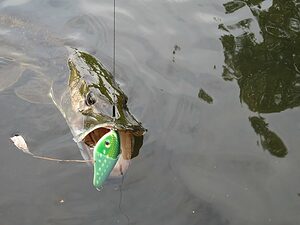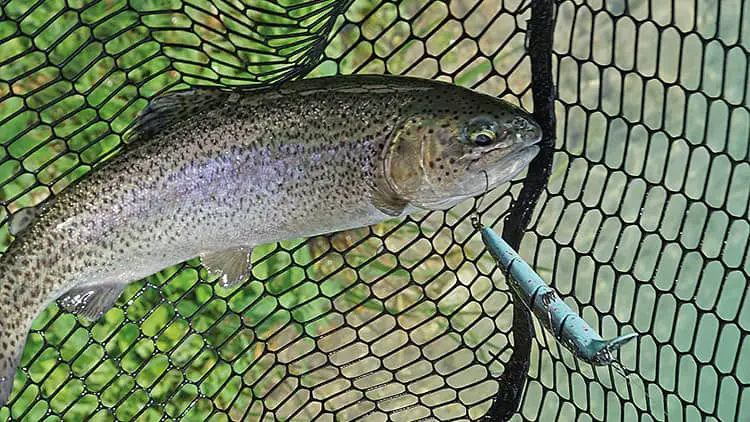Disclosure: Some posts contain affiliate links, which earn us a commission if you make a purchase through them. Positive Fishing © participates in various affiliate networks including the Amazon Services LLC Associates Program.
A jerkbait is one of the most effective lures for catching predatory fish like bass or pike. Their amazing swimming action and various depths a jerkbait can be fished at make them incredibly versatile.
But fishing jerkbaits properly isn’t just about casting it out and winding it in; there is much more to it if you want to be as successful as possible. This comes down to how you retrieve them, your choice of jerkbait, and where you’re fishing.
Join me as we run through everything about how to fish a jerkbait so you can see the benefits of increasing your catch rate the next time you cast one out on the water.
What Is A Jerkbait?

predator fish such as pike, musky, and zander
Before we go into how to fish a jerkbait, let’s first talk about what one is so we are all on the same page.
A jerkbait is a plastic lure shaped like a fish and usually painted in a range of colors to match the color of baitfish or be very visible in the water.
They come with a lip on the front of them that catches the water, causing them to dive and wiggle as they go, creating an action that predators like bass and pike can not resist.
The Rapala lures are one of the most common you have probably seen and used before. These are all jerk baits, and they can be fished trolling or casting with spinning or baitcasting gear. This article will only discuss the casting method, as trolling is just dragging a jerkbait behind a boat.
What Types Of Jerkbaits Are There?
You will find an extensive range of different sizes on offer, and ones that sink or float, swim at different depths and come in different colors.
It’s always best to have a range of jerkbaits in terms of size, swimming, depth, color, and whether they sink or float, as that way, you’ll be able to match the right one to what the fish are feeding on.
Jerkbait Sizes
jerkbaits come in a range of sizes from 3 inches in length to 12 inches in length. The best lengths for bass are between 3″ and 5″; larger lengths (over 6″) are best used for muskie, pike, and other large saltwater predators.
Jerkbait Swimming Depths
jerk baits come in three swimming depths, and you should have a range in your tackle box to fish all the different parts of the water column. Here are the different swimming depths you can select from:
- 0 to 3 feet (shallow)
- 4 to 7 feet (mid-depth)
- 7 to 12 feet and more (deep)
Floating And Sinking jerkbaits
Floating jerkbaits are incredibly useful when fishing over shallow waters as you can ensure you don’t get snagged on the bottom by letting the lure float above it as you fish it.
But, you will also need some sinking options to fish the deeper waters when the fish are holding below the surface.
How To Fish A Jerkbait

When fishing a jerkbait, you don’t want to simply wind them in. Ideally, you want them to jerk around on the retrieve to imitate an injured baitfish looking for cover. This excites the predators, as it looks like an easy meal.
The best way to fish a jerkbait is with a snap pause retrieve, and here is how you do it:
- Cast your jerkbait to an area where you think fish are holding
- Start with your rod at the 4 o’clock position, pointing toward the water
- Keeping some slack in the line, snap your rod down towards the water to the 5 or 6 o’clock position
- This jerks the jerkbait in a frenzied action
- Return the rod to 4 o’clock and wind in the slackline, leaving a little slack for your next snap
- Snap it down to 5 or 6 o’clock again and repeat the process
- While following the steps above, you should create a rhythm of jerk, jerk, pause, jerk, jerk, jerk, pause, etc
- The pause is significant as it gives the jerkbait a chance to rise up and down the water column, too, and gives time for a predator to get into the biting zone
These are just the basics of how to fish a jerkbait, and you need to evolve from here to be as successful as possible using them.
Change Up Your Retrieve
You should change up your retrieve and continue to do so until you find what works. Different ways of retrieving include snapping to the side instead of down, as this causes the jerkbait to swim a little differently.
You can also vary your jerk pause combinations and vary your speed accordingly. When fishing with a deep diving jerkbait, snapping too fast will have it diving much faster, so you should slow it down a bit.
The key to all this is experimentation and trying new things until you find what the fish want to eat on a particular fishing day.
Think About Water Temperature And Adjust Accordingly
When fishing, it’s always important to adjust for the conditions, and temperature is one of the main ones to watch. Bass, for example, will be more active when the water is warm and less active when it’s cold.
If you’re fishing a jerkbait in warm water, snap quickly and sharply while pausing for a short time, and you should get some quick reactive bites as the bass are active.
When fishing in colder water, a solid snap is still a good idea, but you should pause a lot longer as the bass will have less energy and need the long pause to catch up and eventually eat the jerkbait.
Adjust Your Jerk To The Other Conditions
If you’re fishing on a cloudy or windy day, you can get away with a lot more speed when fishing a jerkbait. Windy days create a chop on the surface, and cloudy days make it harder for the fish to see the baitfish they want to eat.
Pausing for a shorter time will give the fish less time to think and provoke a random attack as they chase baitfish around in poor visibility.
Now, on a still day when the surface is calm, and the sun is out, the fish have the advantage as they can see more clearly what’s around them. This makes eating bait fish a lot easier, and they do not need to rush around chasing minnows at a high rate of speed.
In situations like this, it’s wise to have a long pause so the fish can be lazy and eat your jerkbait at their own speed.
Pause For Longer In Fishy Spots
When you cast out your jerkbait, there will probably be quite a few areas that you think are “fishier” than others. These can be places where you know there is depth change or when you’re bringing the jerkbait past a sunken tree where bass like to hold up.
When pulling your jerkbaits through these fishier areas, it’s wise to pause for longer, as the longer it’s in the strike zone, the more likely you are to provoke a bite.
This doesn’t mean you should always do long pauses, though, as you still want to cover ground, so do it in areas where you think a fish will be holding up.
Work An Area With A Fan Of Casts
When fishing a jerkbait, you will have picked a fishy area but won’t know where exactly the fish are holding. The best way to quickly and effectively cover all these areas is by casting in a fan-like pattern.
Your first cast can be to the left, and then you can slowly make your way around to the right using ten or more different casts to make up the fan pattern.
Adjust For Water Clarity
If the water is clear where you’re jerkbait fishing, you should speed up your snaps and pauses, as the fish won’t go after a bait moving too slow when they can see so well.
But when fishing in dirty water, you need to give the fish as big a chance as possible to find your bait in amongst the terrible visibility. This is also a great time to use an option with a loud rattle so the fish can hear and see it.
What Jerkbait Should I Buy?
The best jerkbait lures are from Rapala, these quality lures are always proven to catch fish, and their shape and design are perfect for catching bass, trout, and predator fish.
While you will need several options, I highly recommend the Rapala X-Rap Jerkbait XR10. You can read more on my favorite Rapala lures and recommendations, including fresh and saltwater options.
If you are a bass fisherman, check out my best bass lure choices, specifically for beginners unsure which types to use when first starting out lure fishing.
Jerkbaits vs Crankbaits?
Some anglers get a little confused between a jerkbait and a crankbait. However, jerkbaits tend to be slightly longer and not as fat in their body shape. Typically, most crankbaits are shorter and have a more round shape.
Another main difference is the number of treble hooks attached to the lure. Jerkbaits generally have three trebles, and crankbaits have two trebles. Please note that this is not always the case; some Rapala options only have two treble hooks!
Lastly, the bill changes the action of the baits in the water. Crankbaits will dive deeper into the water due to their broader and longer bills. The shape of the bill varies from one lure to another, and there are several lipless options.
Both jerks and cranks come in various colors, shades, and patterns. Remember, both these lures mimic an injured fish, so choose the color/shade/pattern criteria based on the minnow or fish that frequent the river or lake you are fishing in.
Final Thoughts
Thanks for reading my article. I hope you found it helpful and now know all the tips on fishing a jerkbait as effectively as possible. It’s all about getting the initial technique down and then experimenting based on conditions and species.
Before you go, why not check out some of our other articles on baits and lures, which cover both natural and imitation baits for many species. Or check out my section on over 40 fishing destinations worldwide, from the Americas to Europe, and Asia.
- Top Tips For Fishing With Feathers - January 15, 2025
- How To Fish For Flounders: Tips, Rigs, & Baits - March 27, 2024
- Fortis Wraps Fishing Sunglasses: The Affordable Option For Anglers - January 25, 2024



